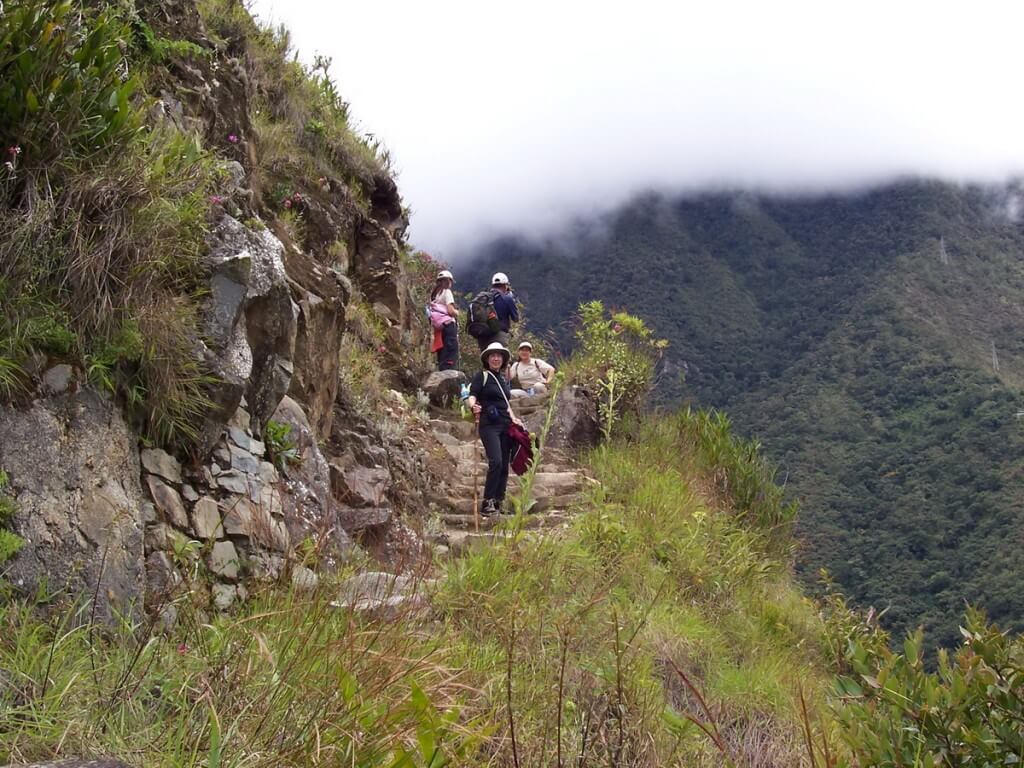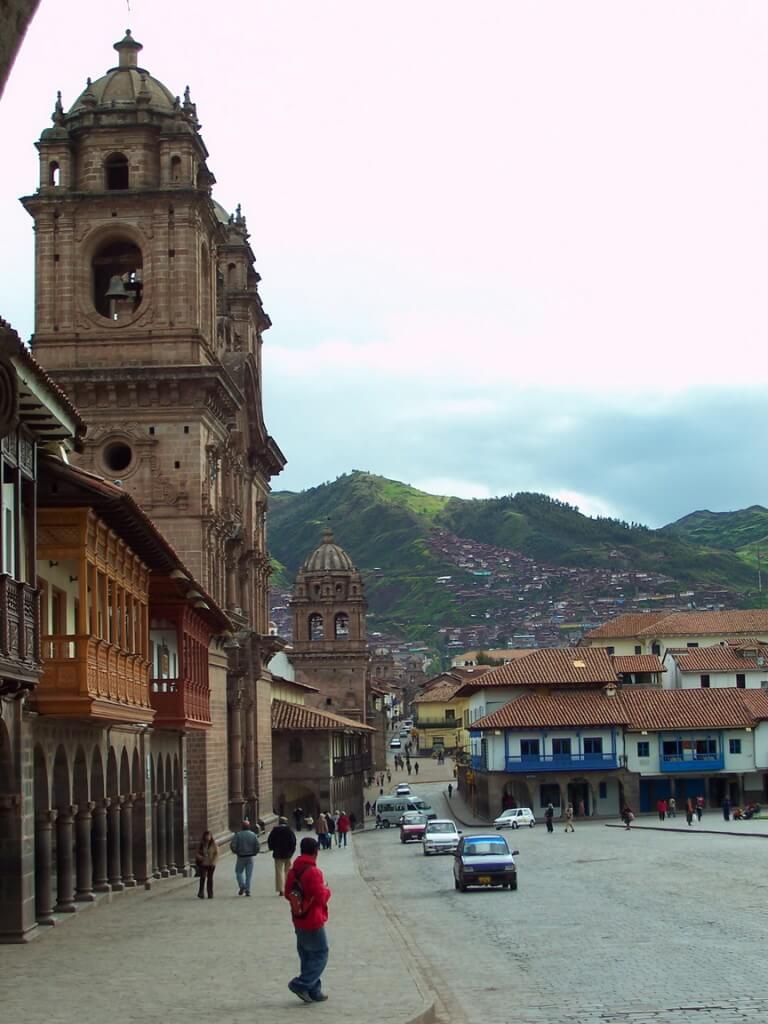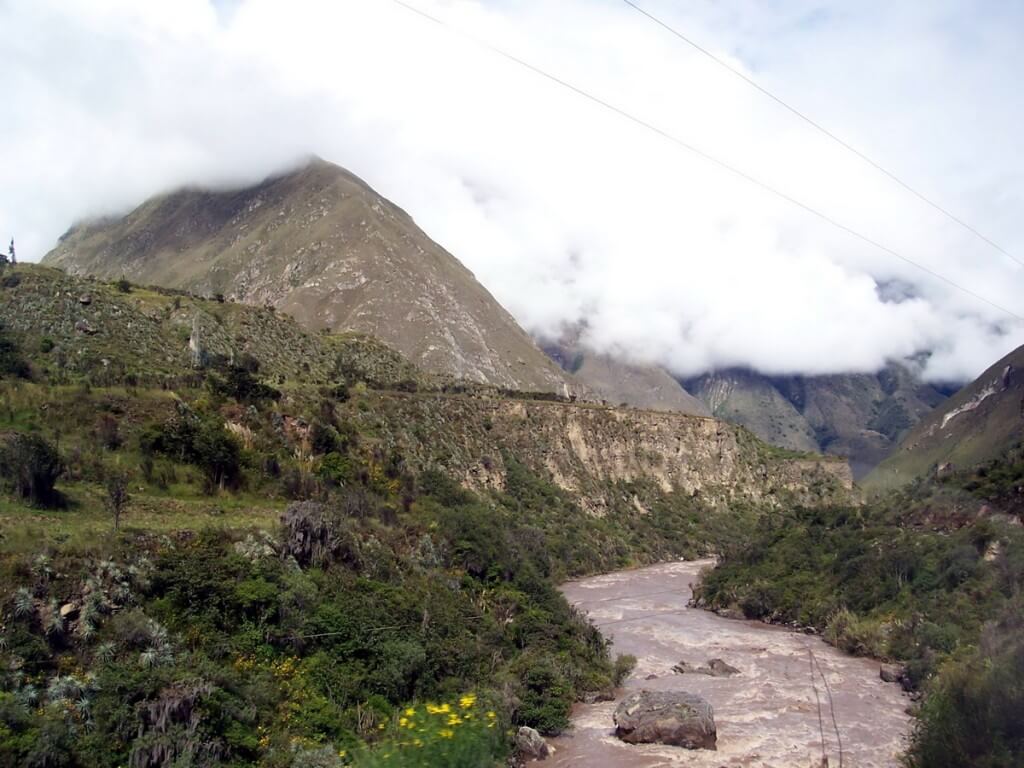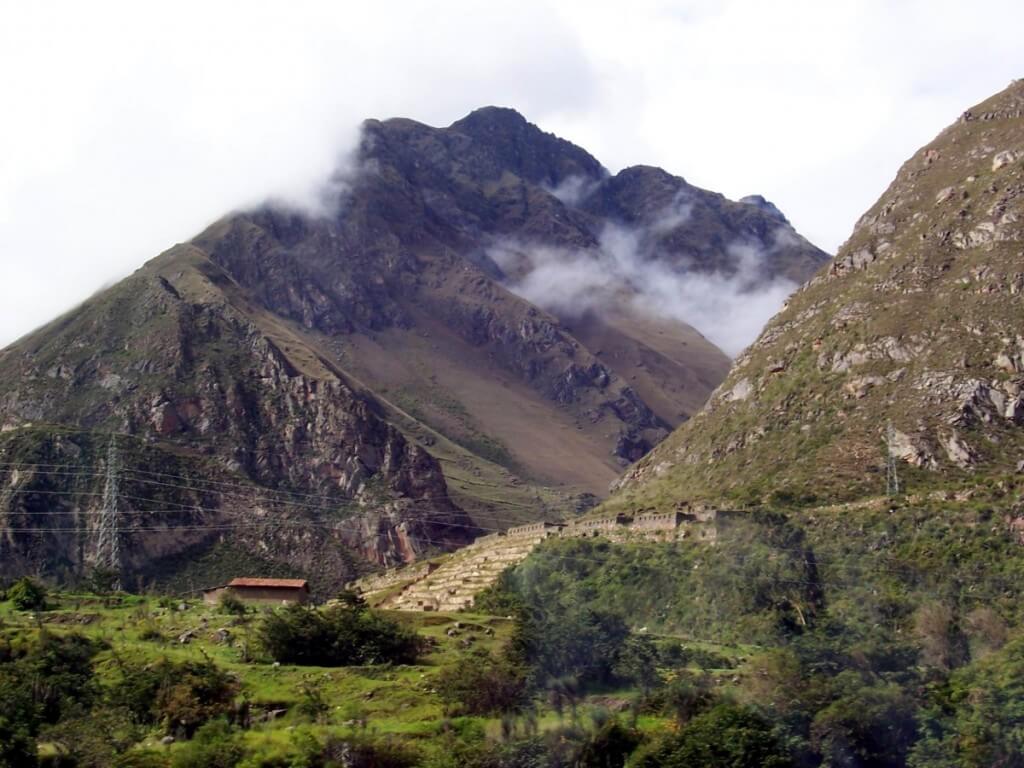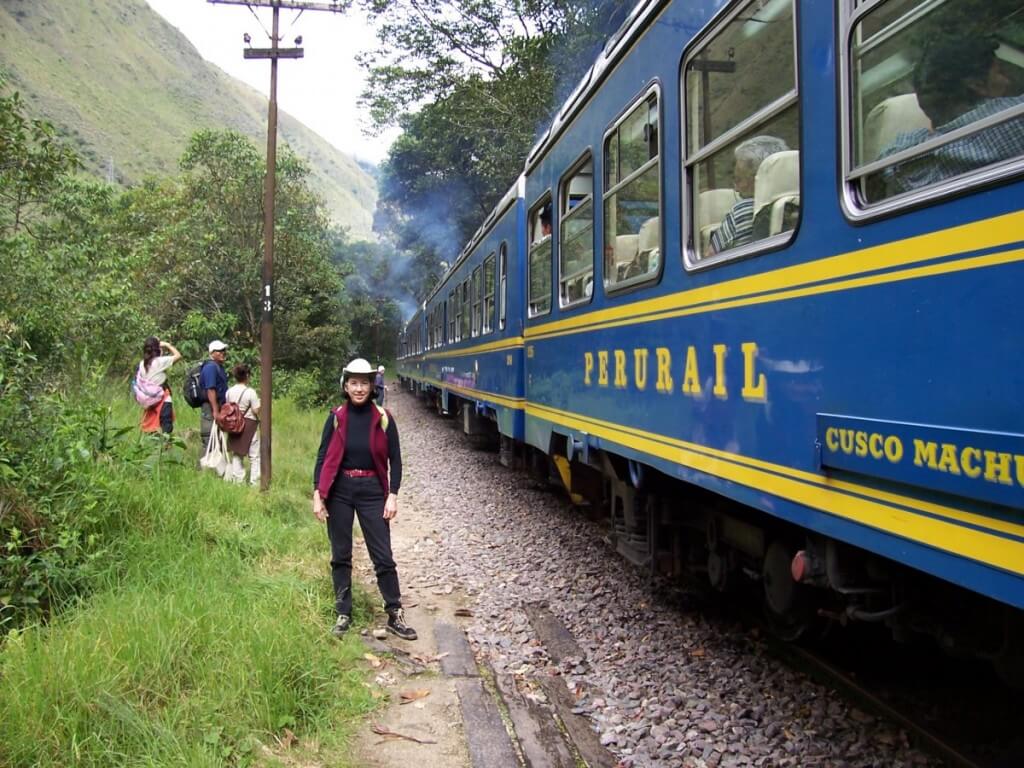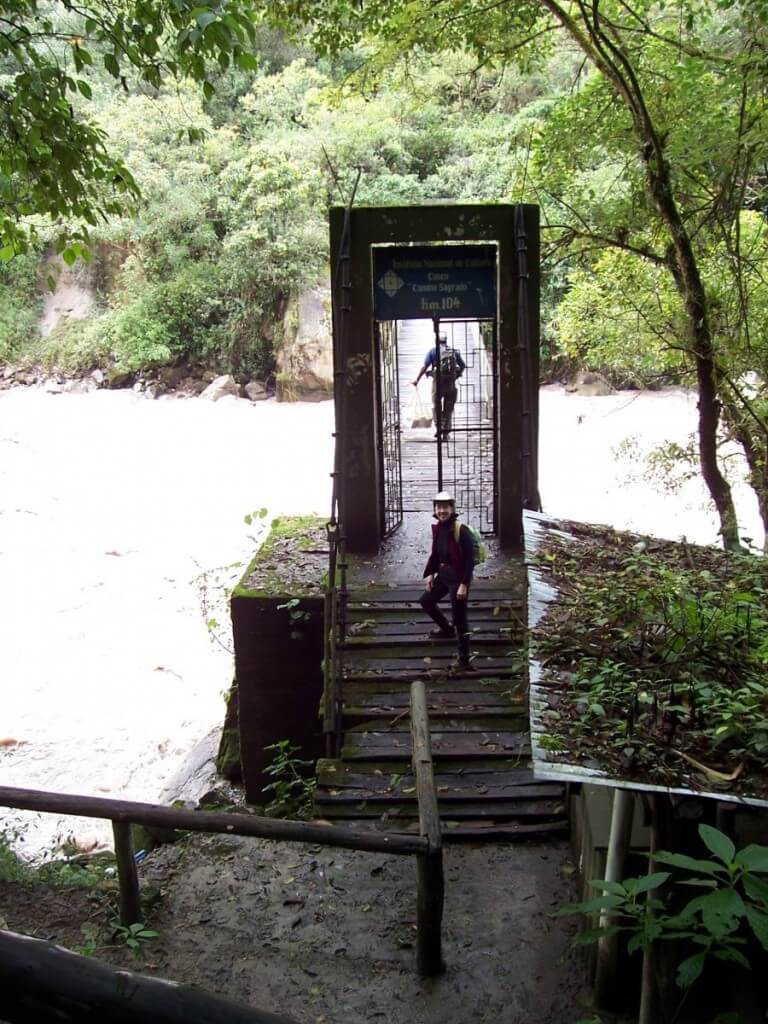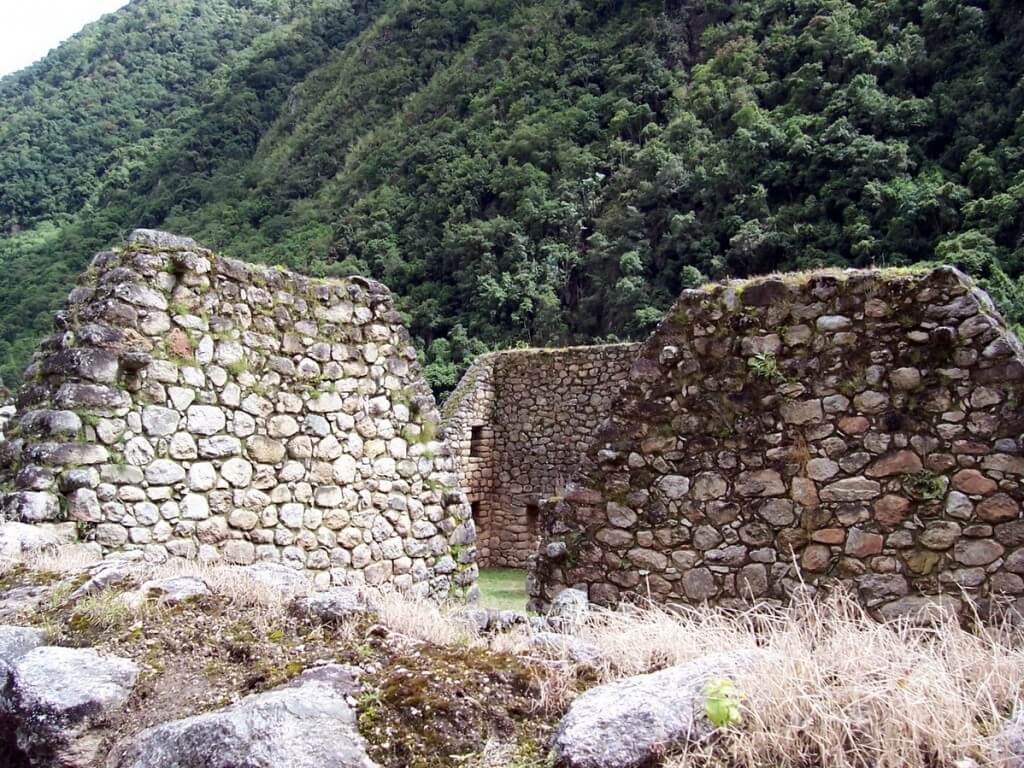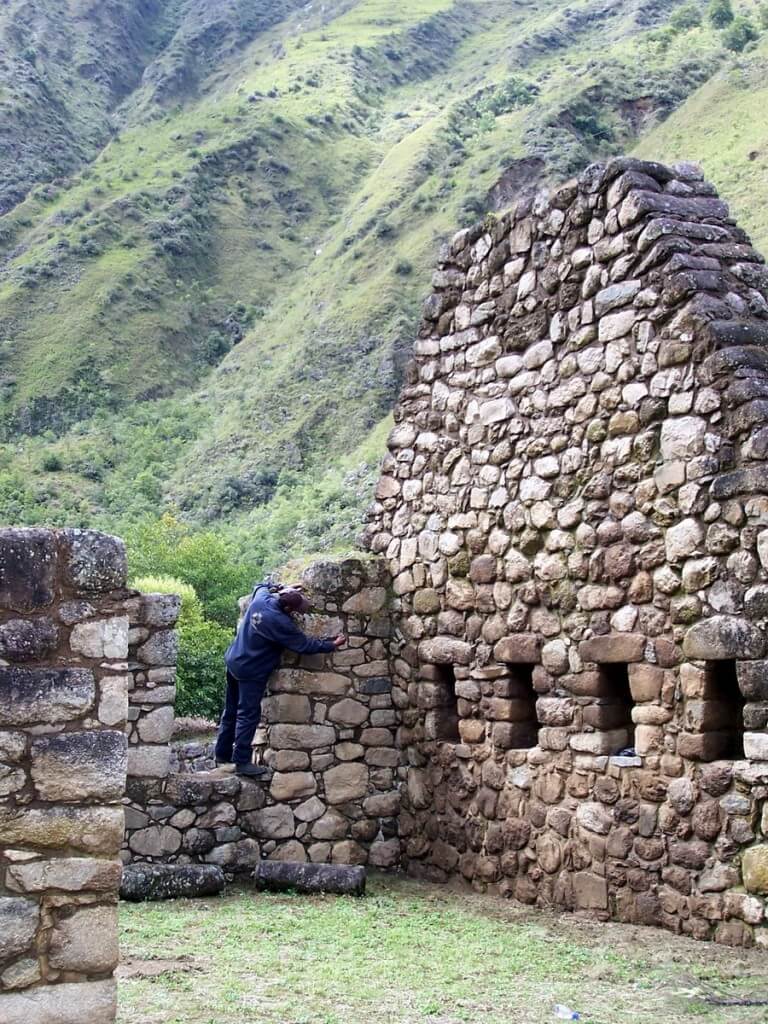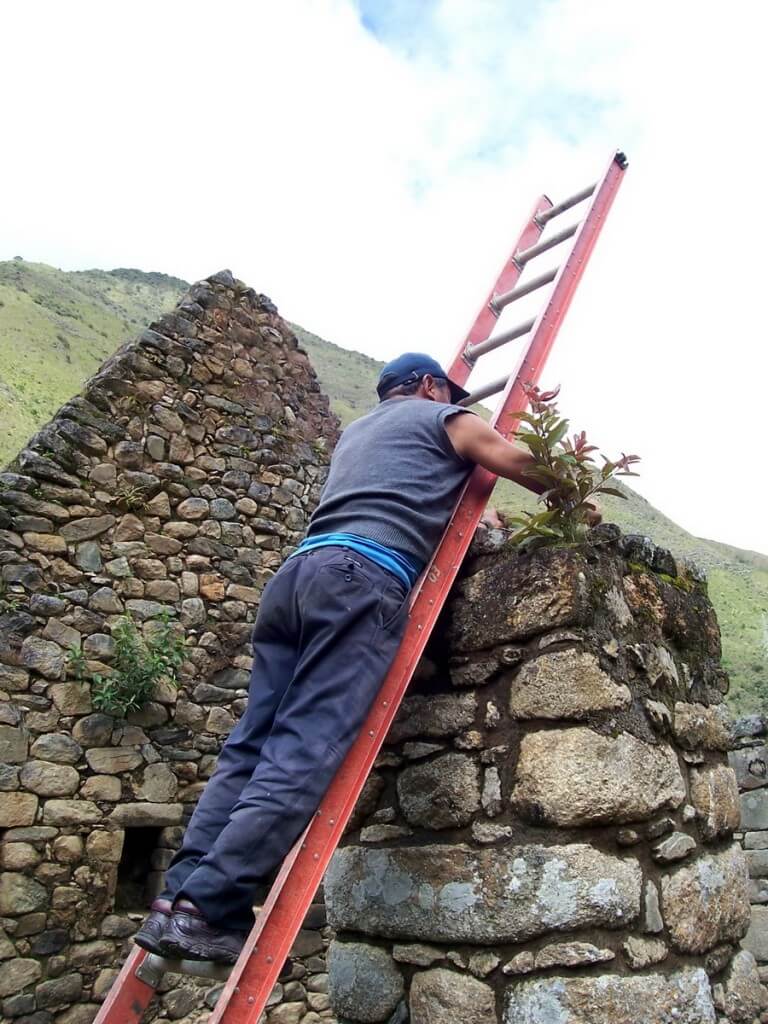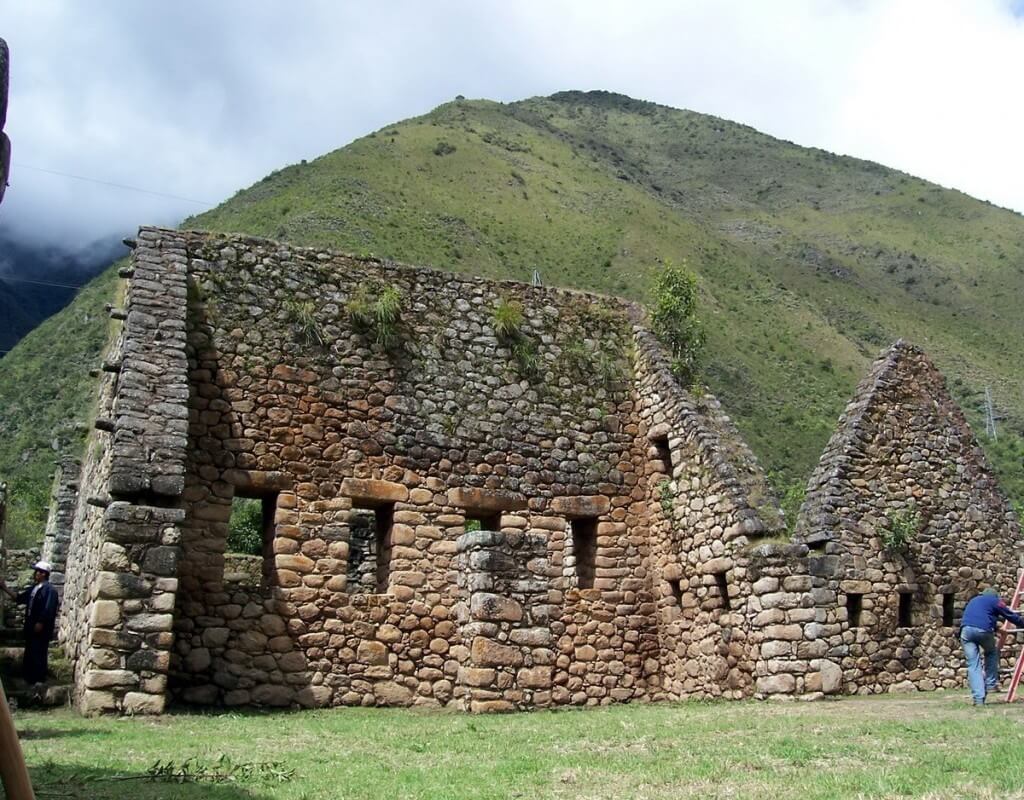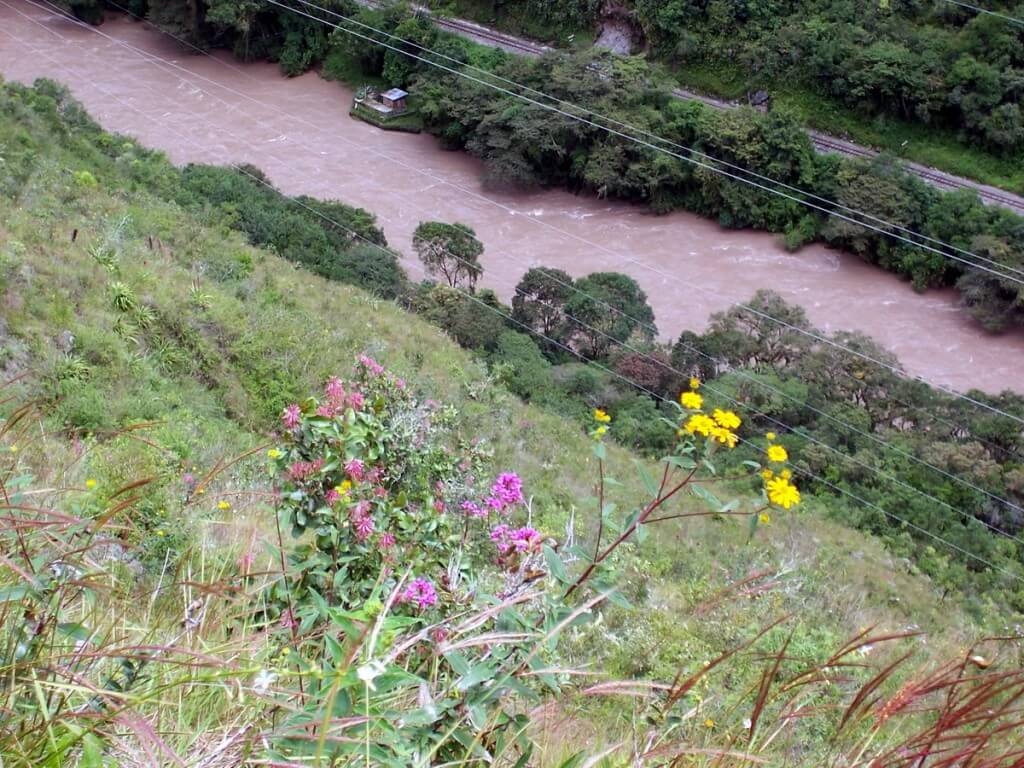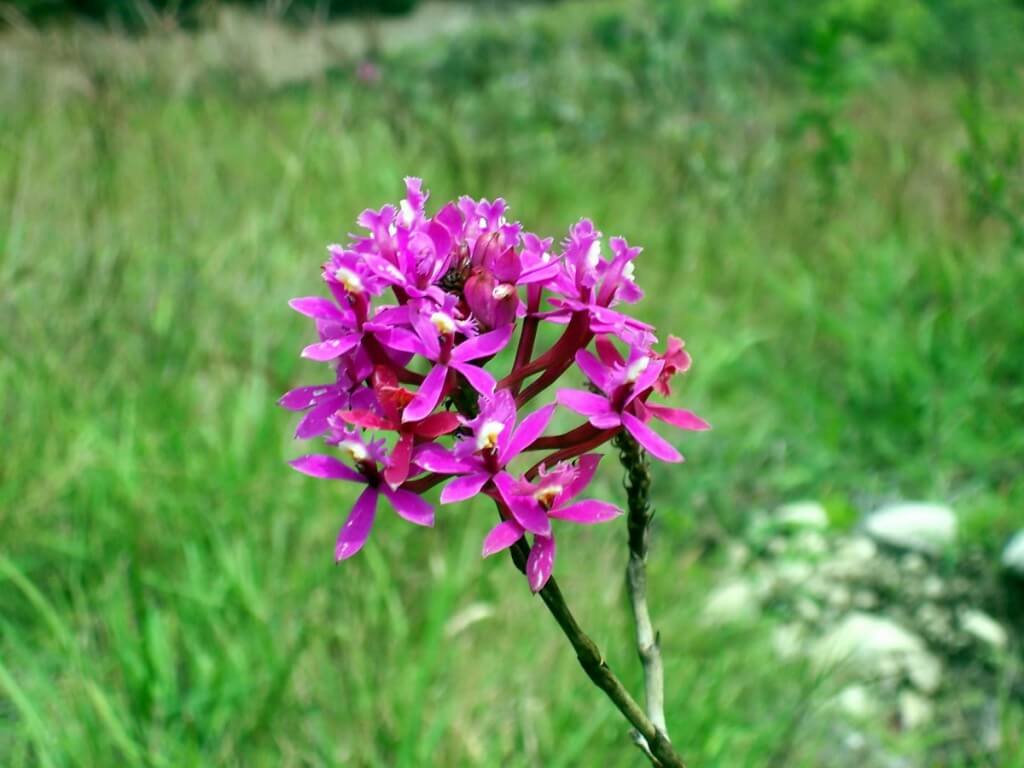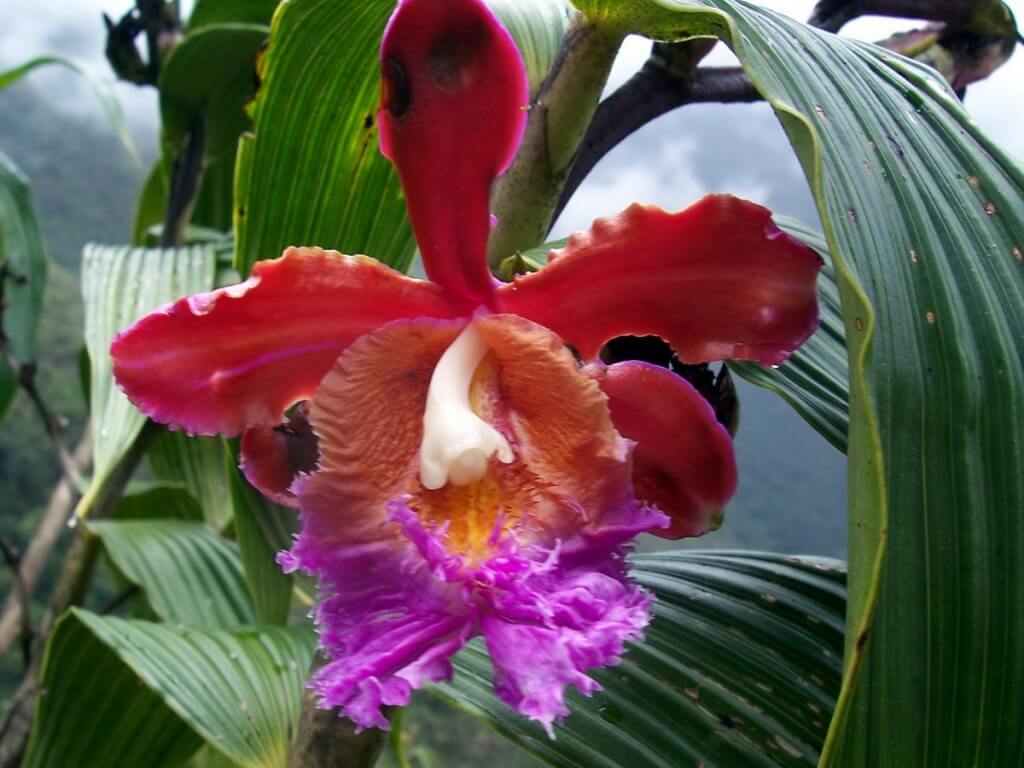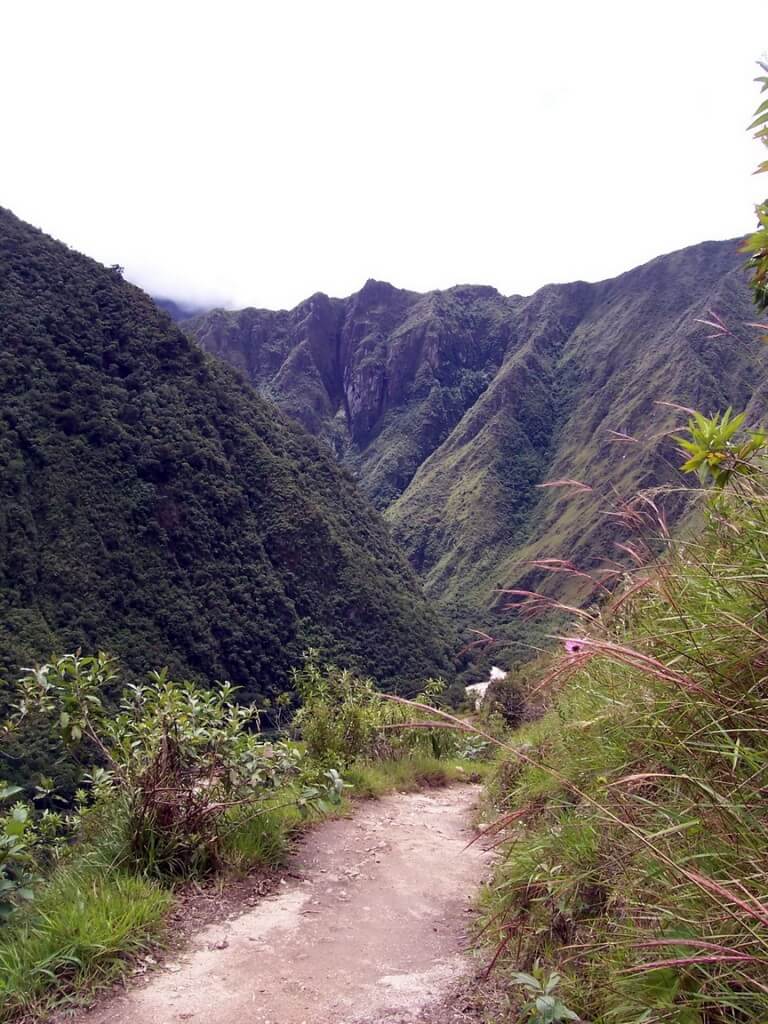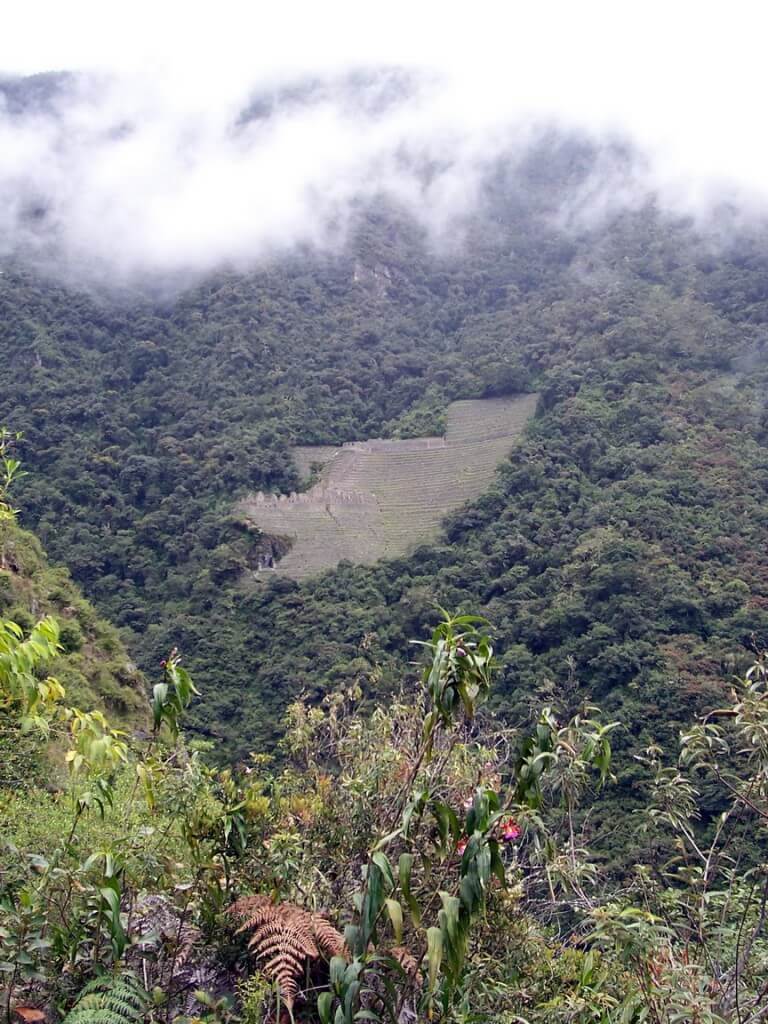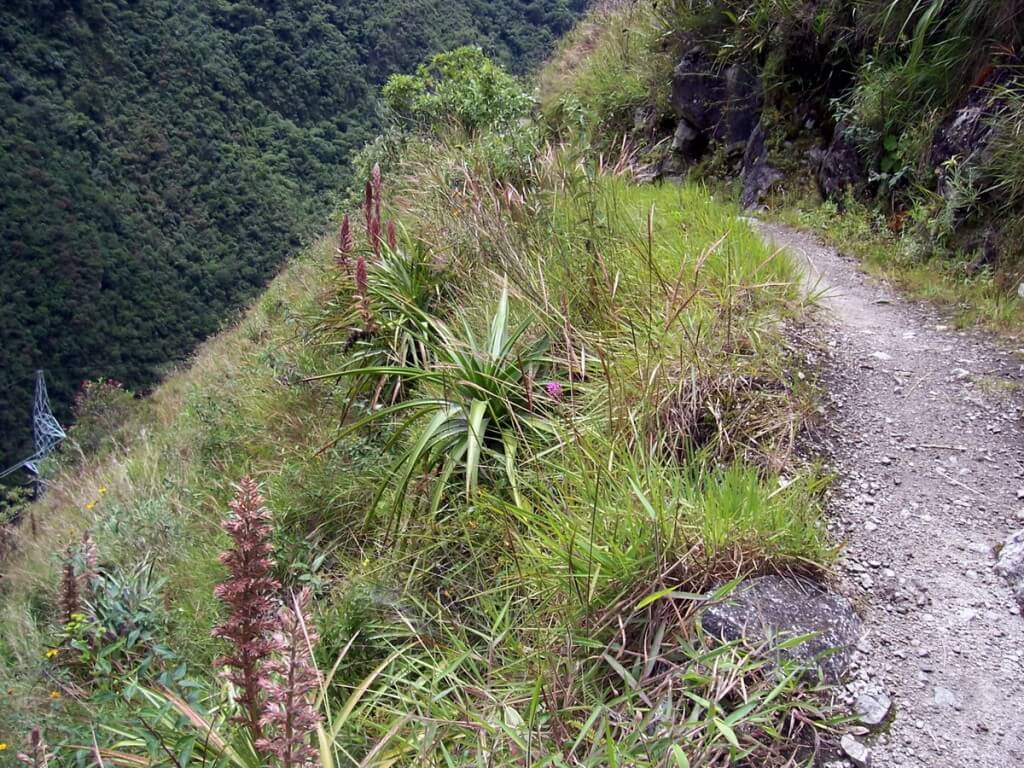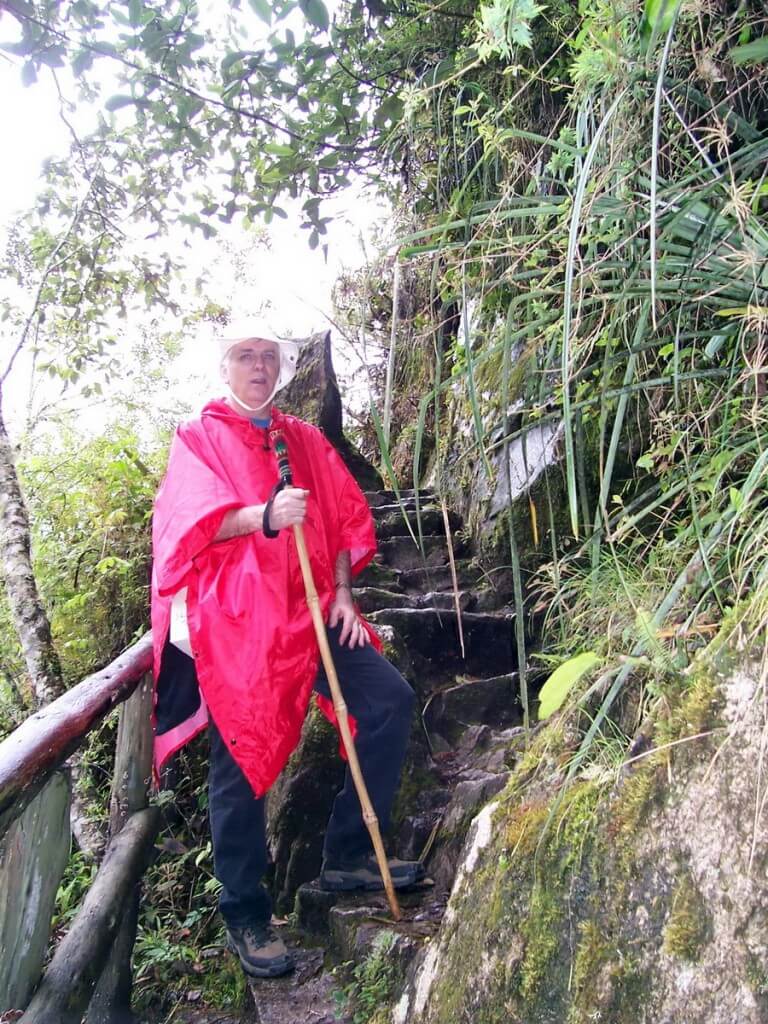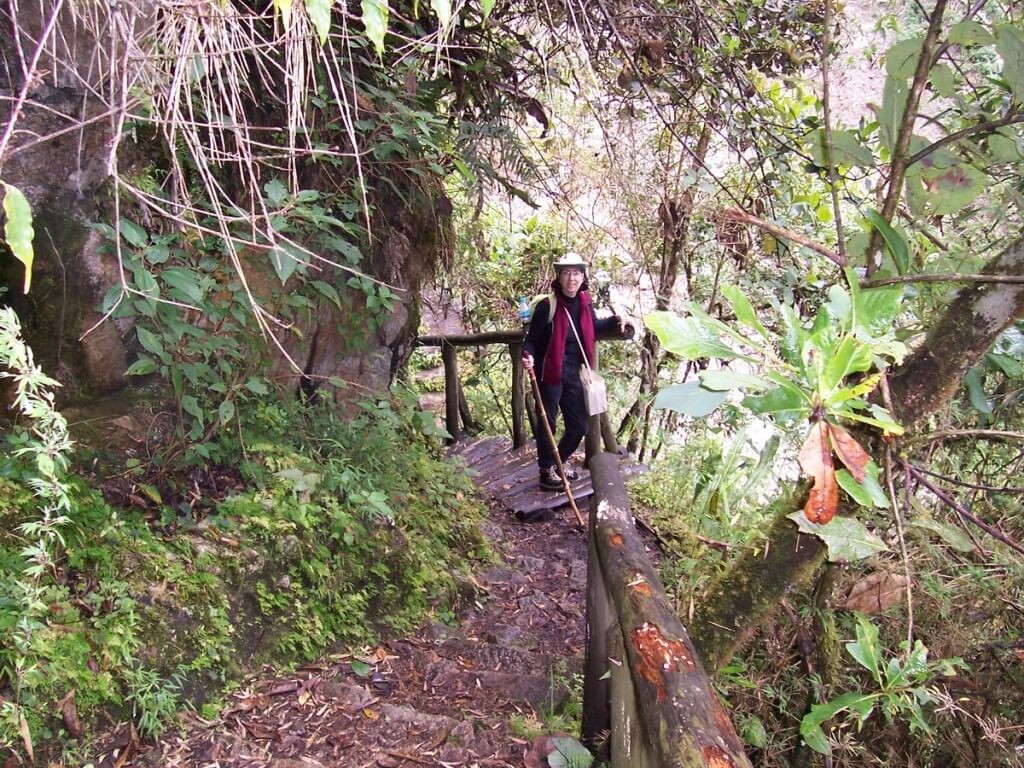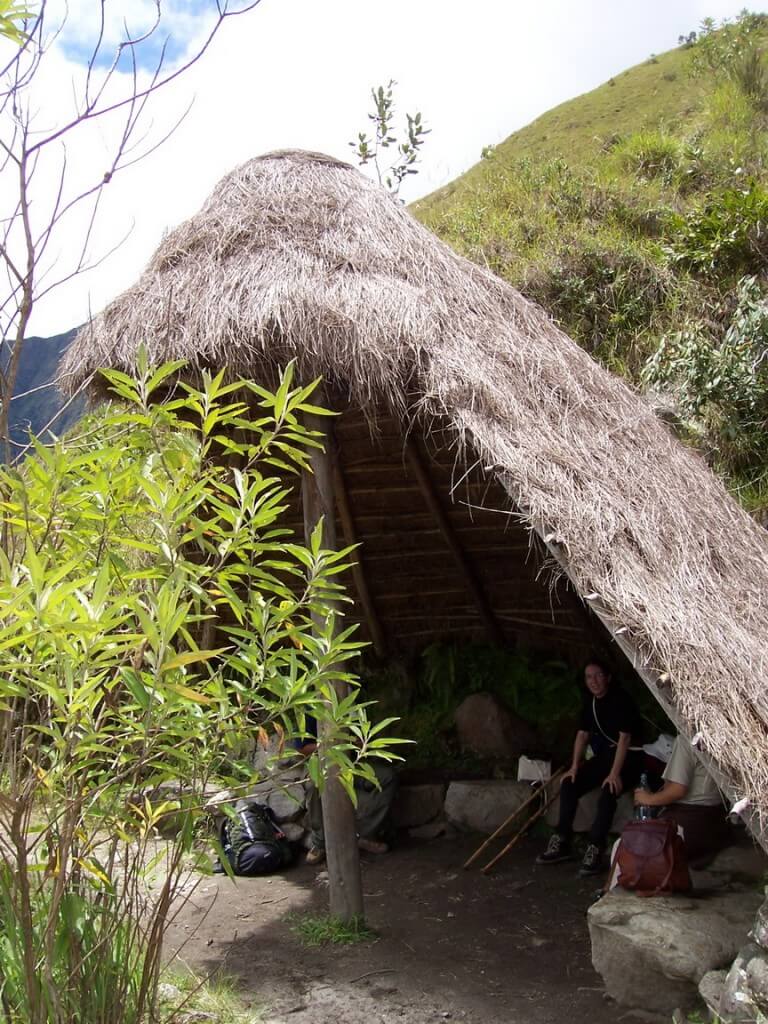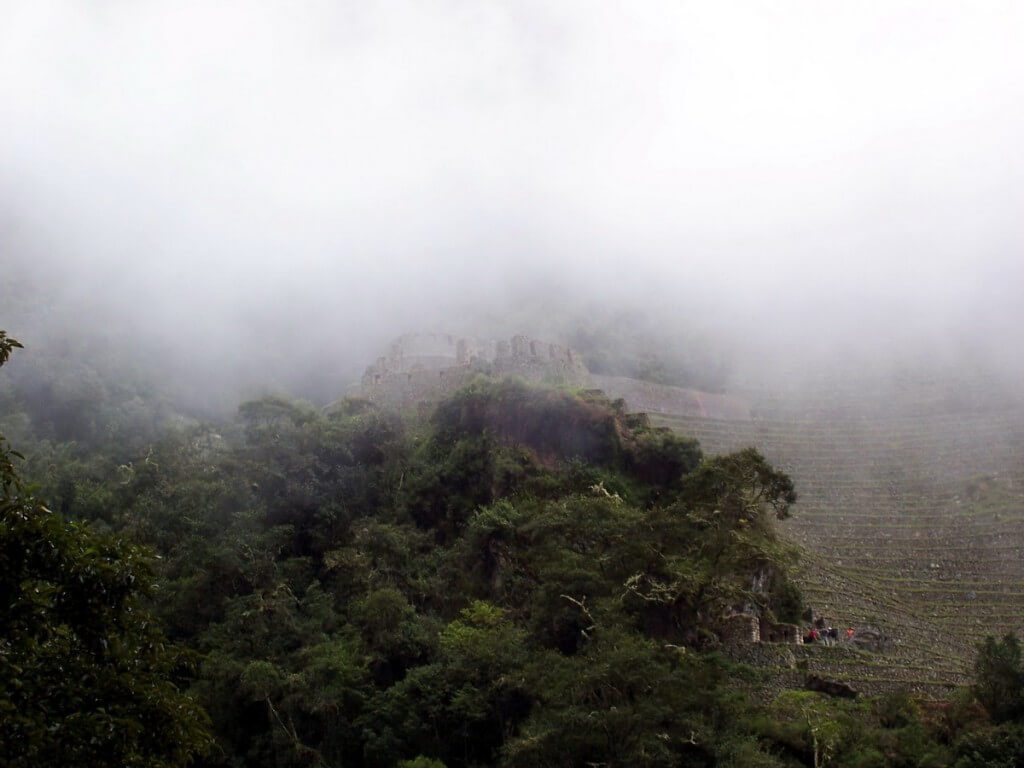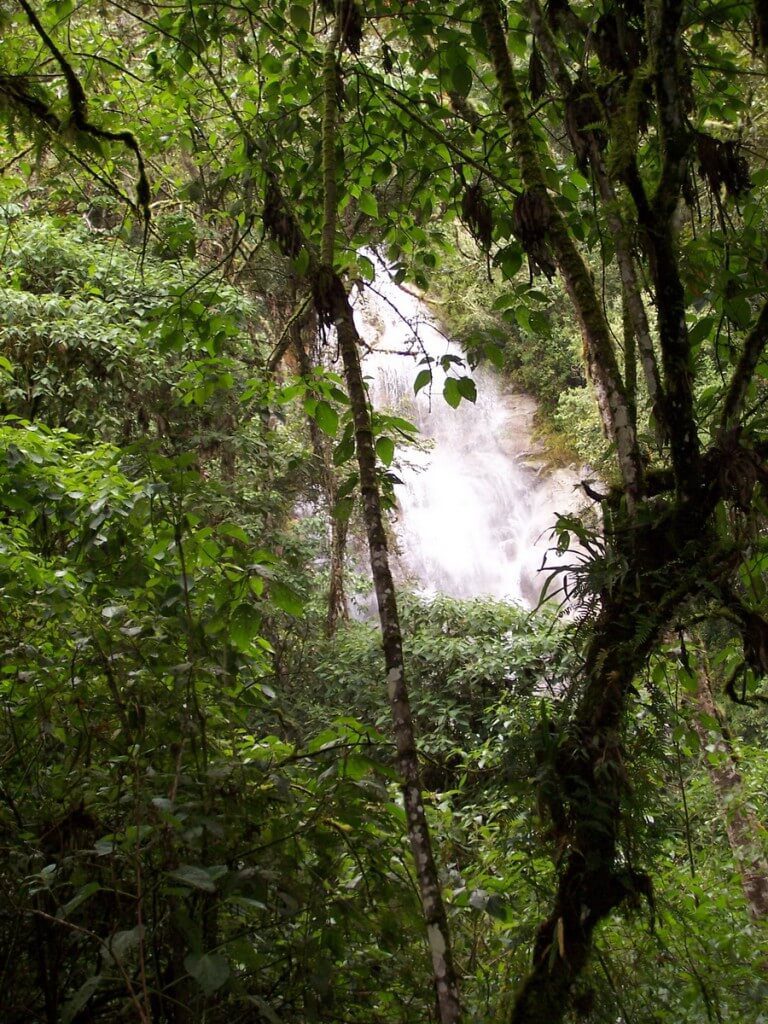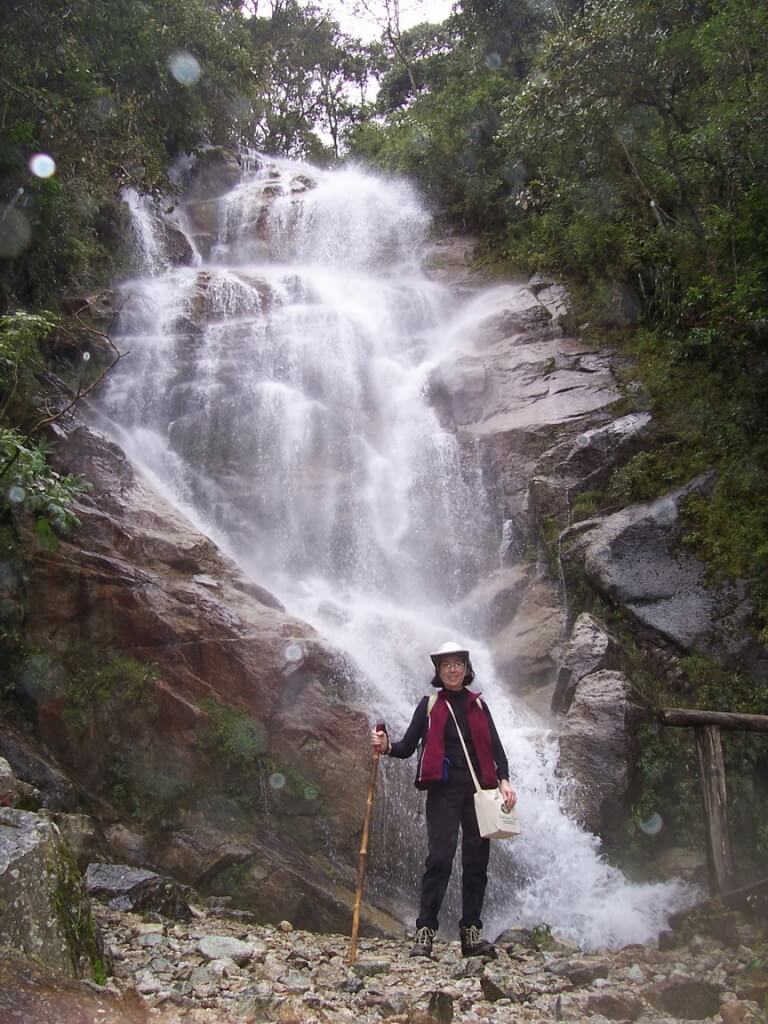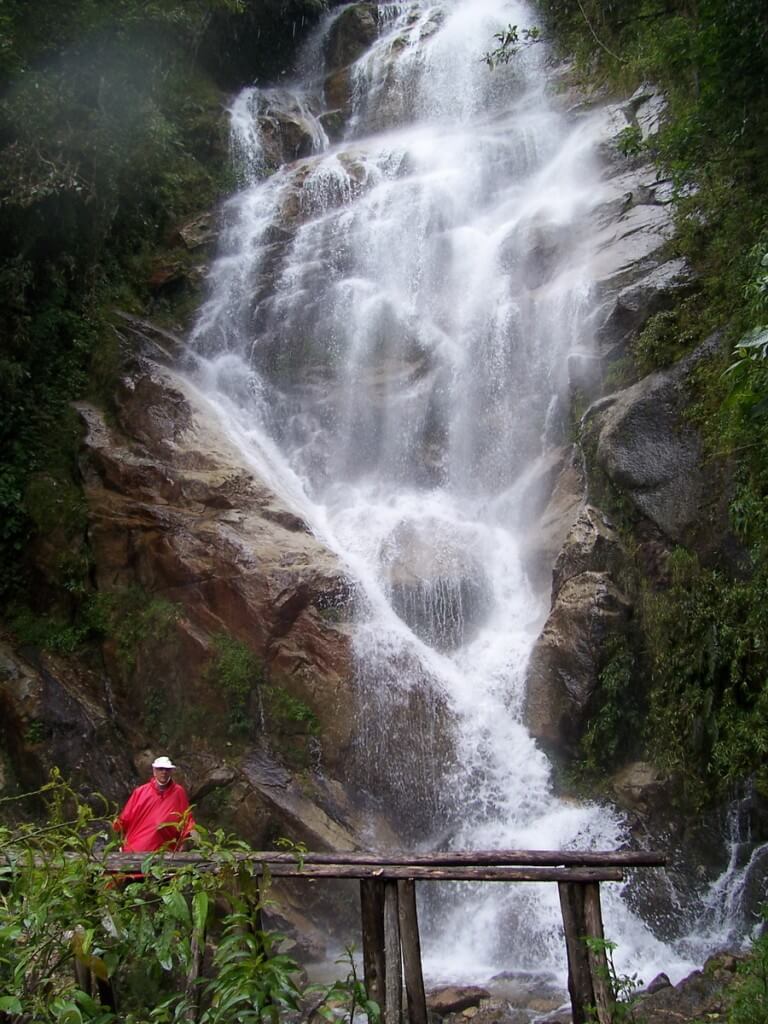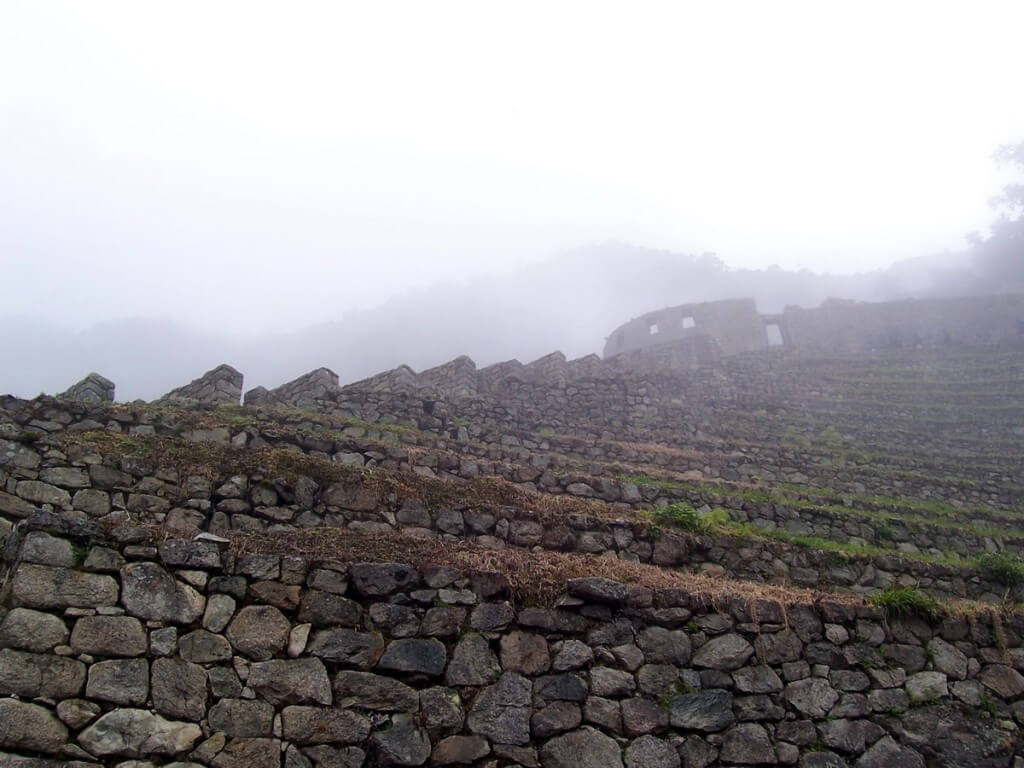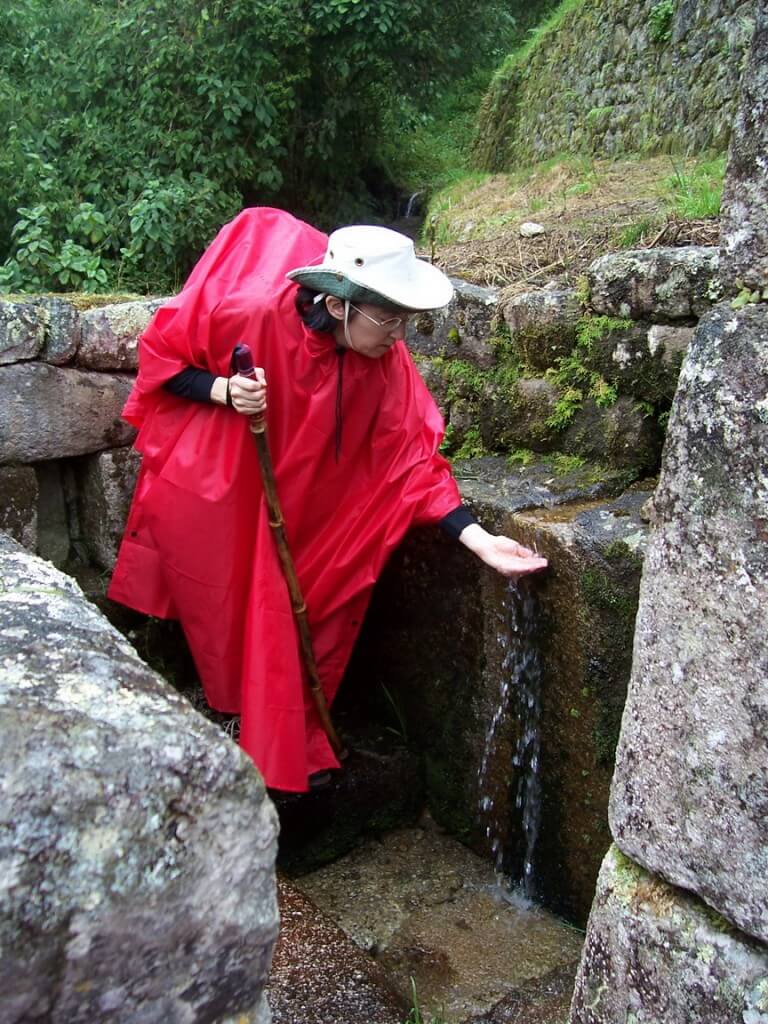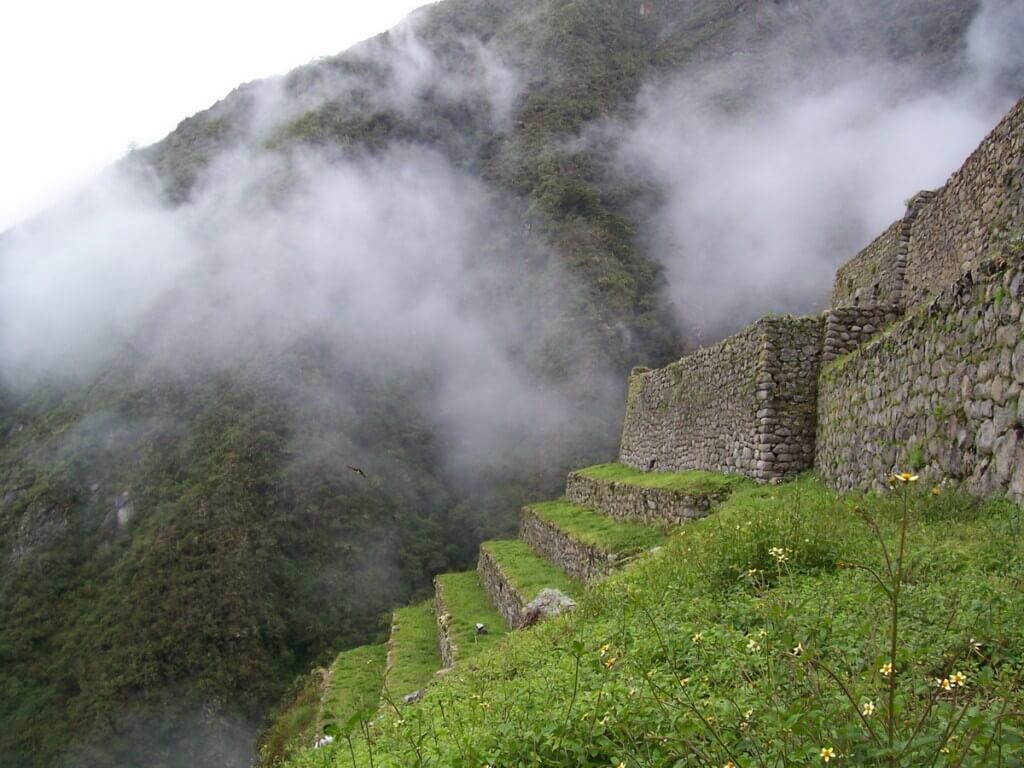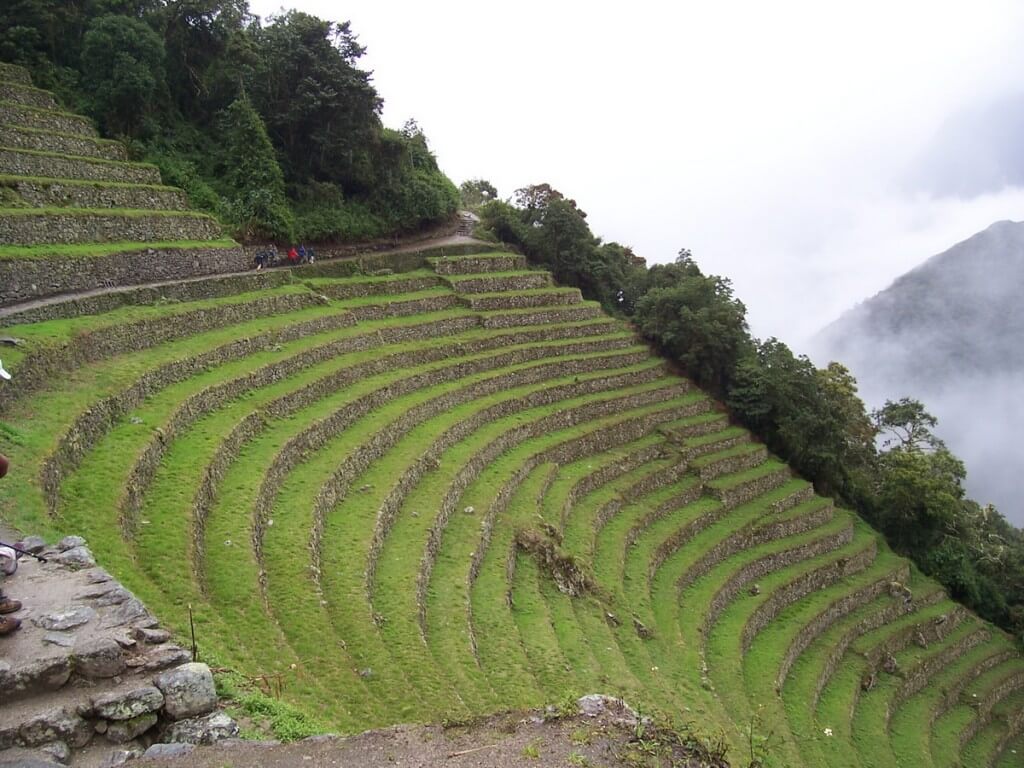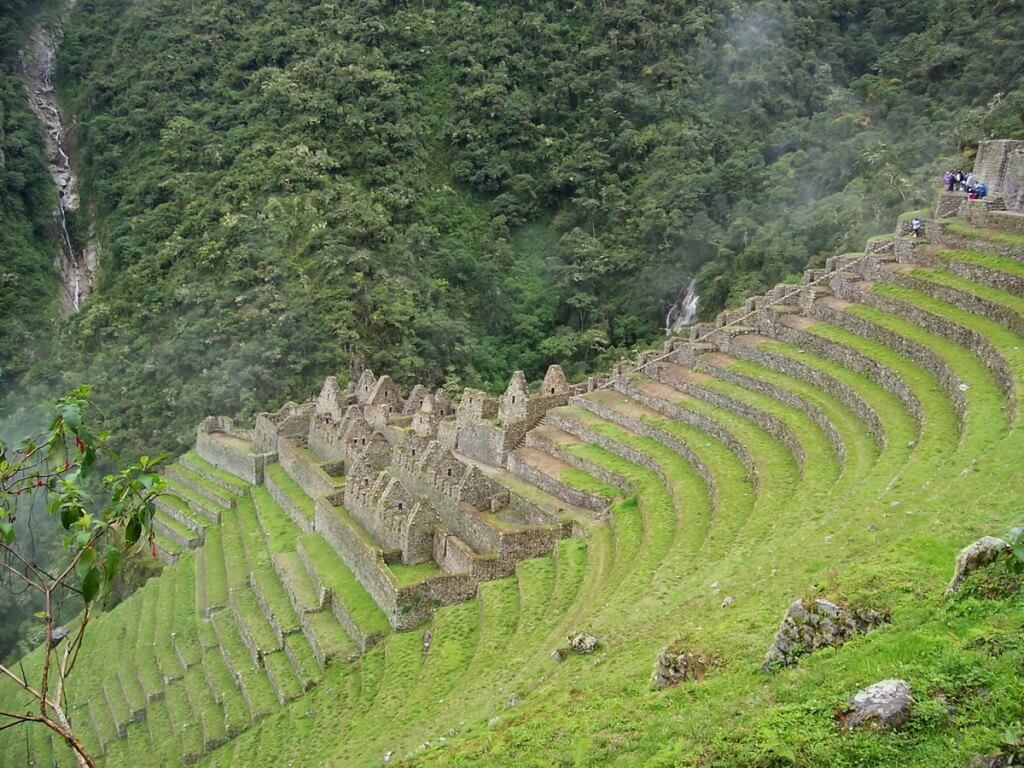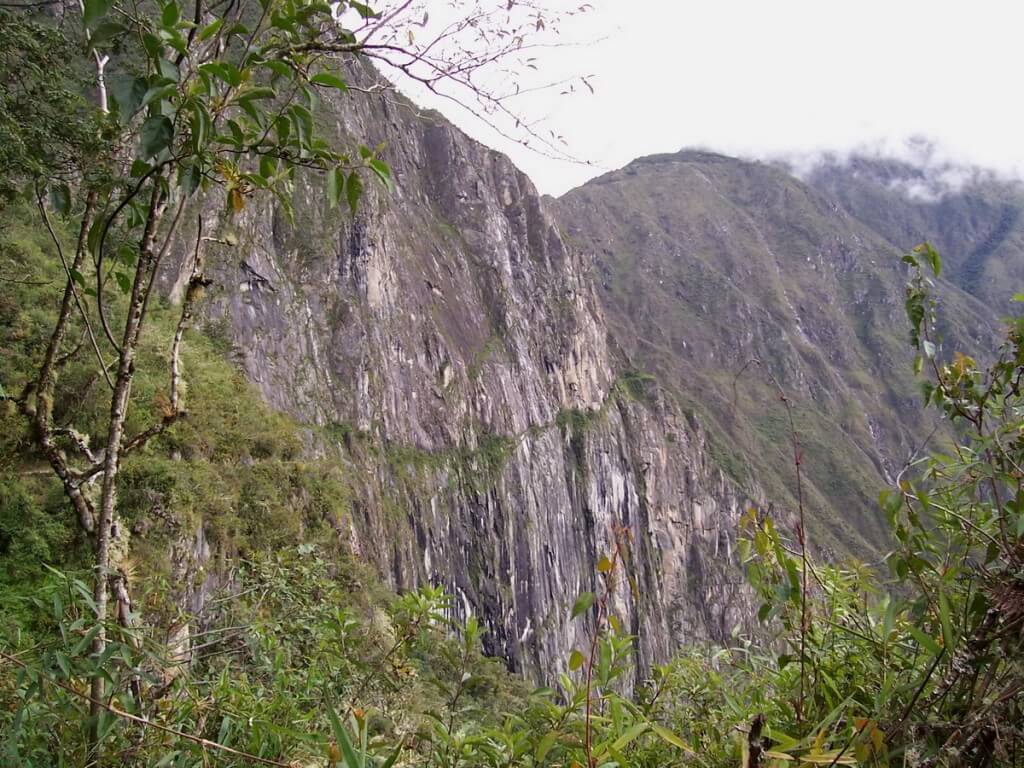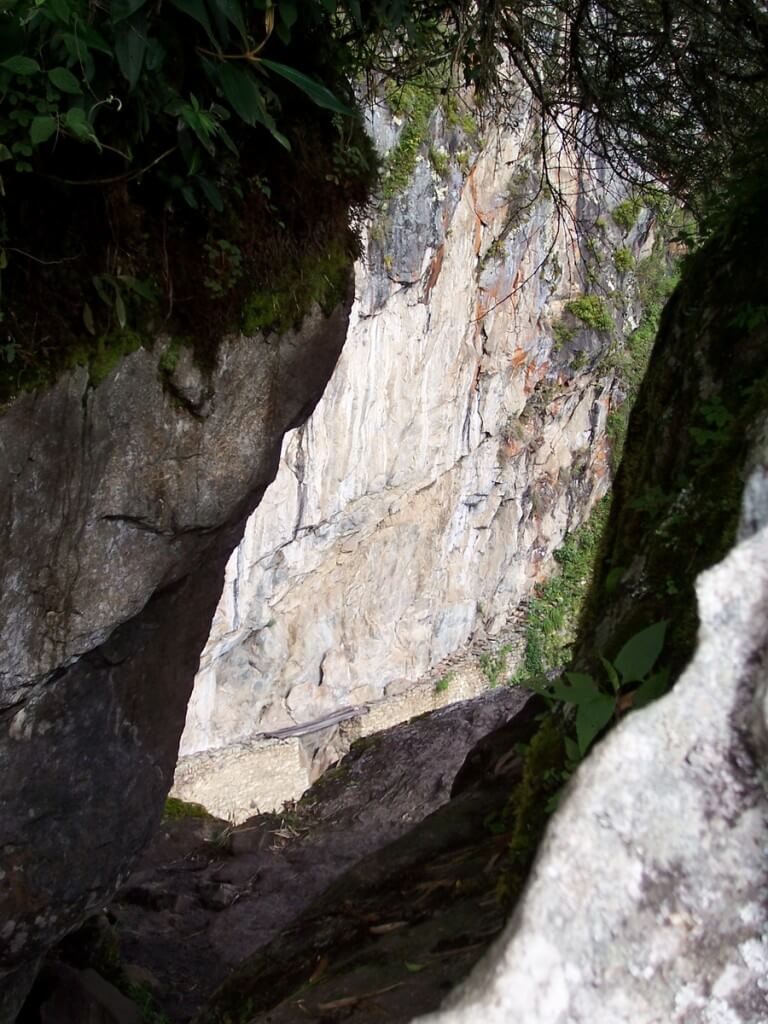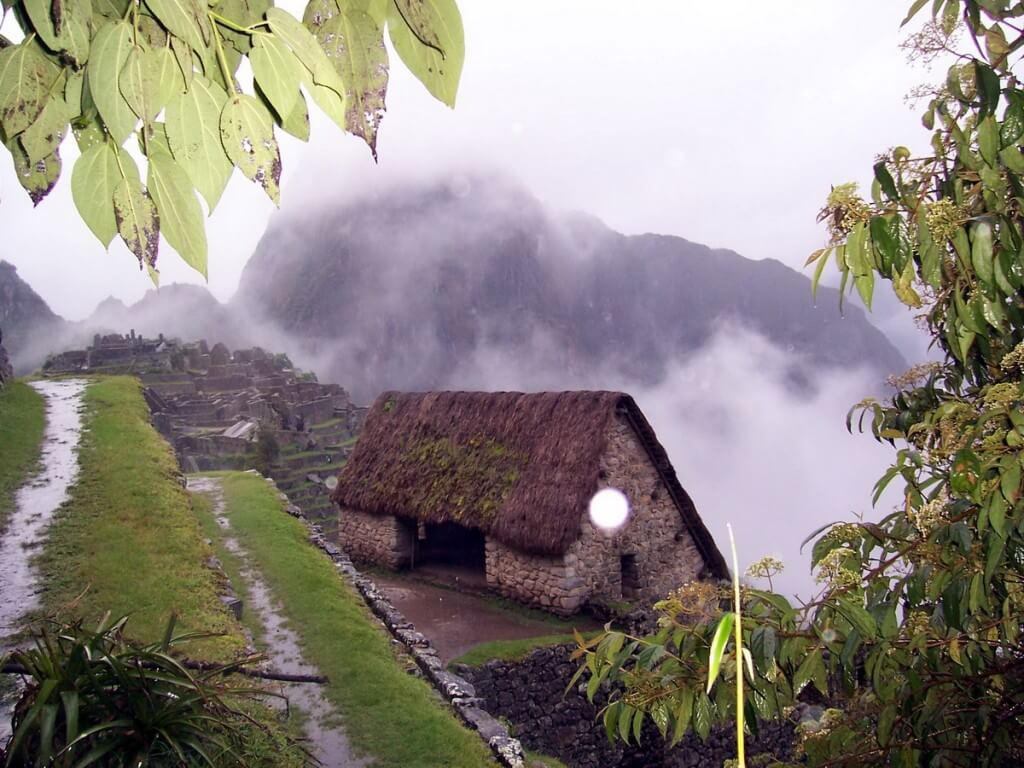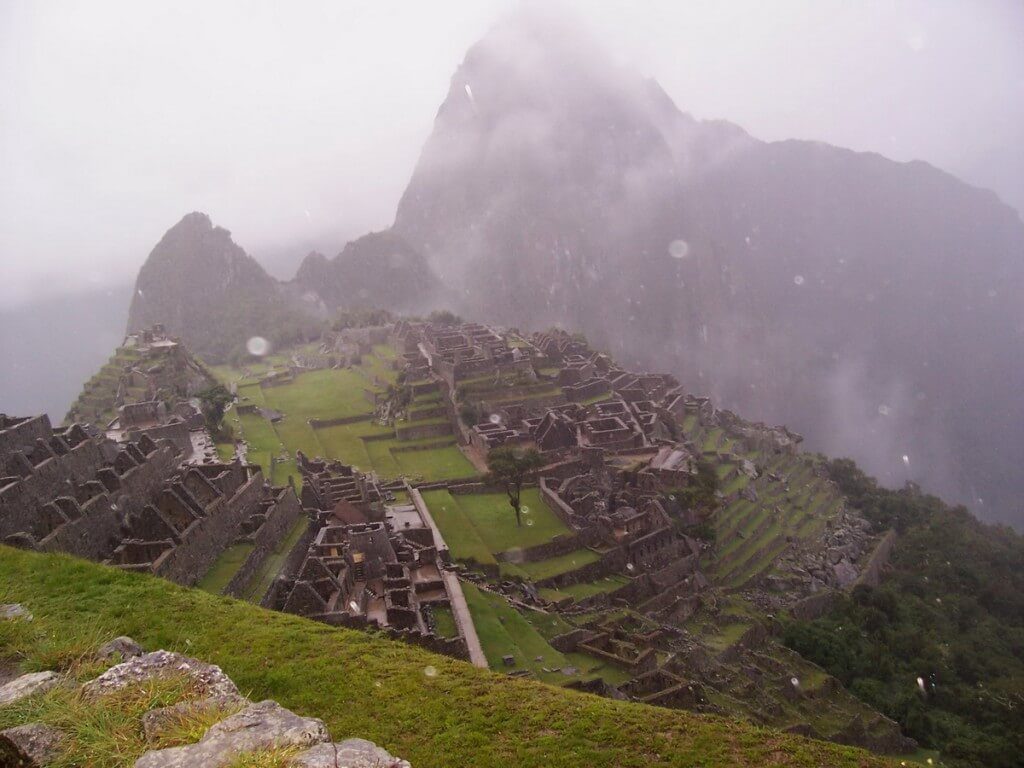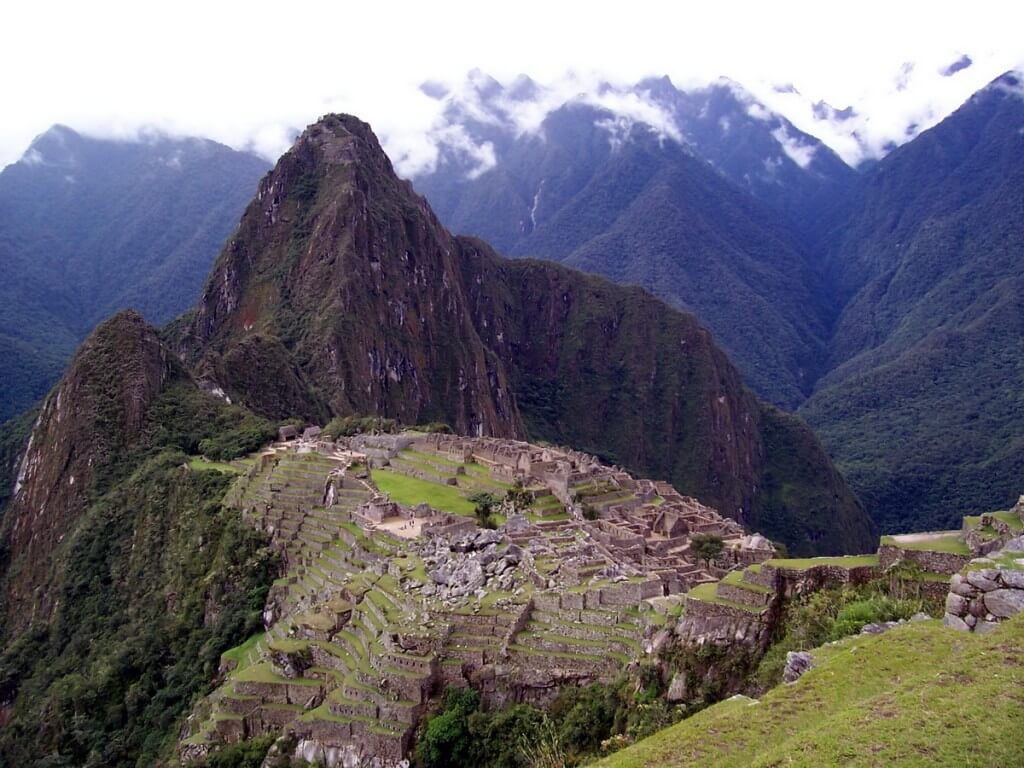Hiking the Inca Trail – Our Adventure of a Lifetime
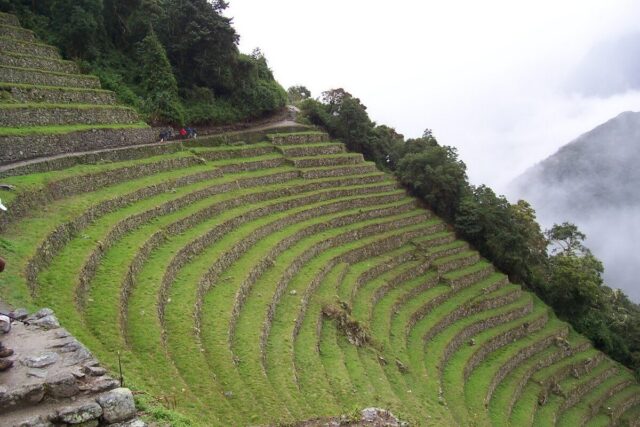
When it was finally time to set foot on the Inca Trail, we were guided by an authorized trail guide and accompanied by two other hikers, guides in training. Our adventure would be a one-day hike along the time-worn Inca Trail, headed for Machu Picchu. Our excitement was palpable.
The day we were scheduled to hike the Inca Trail, the alarm was set for 4:30 a.m. so we could ready ourselves for the hike and get to the Cuzco train station on time. Our trail guide was to pick us up at the hotel promptly at 5:30 a.m. so Bob and I had a rushed breakfast and then headed to the lobby. Our stress level skyrocketed when the guide didn’t show up! The train departs at 6:00 a.m. sharp! At 5:45 a.m., our guide finally appeared, and within 10 minutes, we were at the train station. Seconds later, the train whistle sounded.
The train made a very slow ascent out of Cuzco and then chugged its way methodically higher into the mountains. The further away from Cuzco that we got, and the closer to Chachabamba at kilometer 104 on the tracks, the drop-off point for the start of our hike, the narrower the valley between the mountains became. The Urubamba River crossed beneath the tracks with tons of raging water surging between its banks.
Steep slopes loomed over us, and at one point, the train carried us past a massive set of Inca ruins on the side of a hill. The scenes were absolutely spectacular.
Finally, the train stopped in the middle of nowhere, or so it seemed, and Bob and I disembarked from the train.
Other than the guide and guides in training, we were the only two people to get off the train. The other hundreds of passengers stayed aboard to ride to Aguas Calientes.
For us, it was time to hike the Inca Trail from Chachabamba into the Sacred City of Machu Picchu through the Intipunku Sun Gate.
At Chachabamba, our guide led us across the tracks and then unlocked the control gate on the river bridge that spanned the tempestuous Urubamba River. I have never seen such a violent river before. The fearsome boiling waters equaled the turbulence at the bottom of our own Niagara Falls except the whole river went on like that for miles and miles and miles. It was truly scary to look at.
Listen to the roar of the raging river firsthand in our video.
A narrow bridge spans the river, and on the far side, there is a checkpoint where hikers entering onto The Inca Trail must register. It is necessary to book your hike on the Inca Trail well before you arrive in Cuzco. The busiest time to hike The Inca Trail is between April and October. The trail is normally closed in February for renovations and repairs. Under Peruvian law, no one is allowed to hike The Inca Trail without a reservation or without a registered hiking guide.
This map of the Inca Trail shows the route we hiked from Chachabamba to Machu Picchu.
At the Inca site of Chachabamba, situated along the Urubamba River, volunteers were busy doing restoration work on the ancient buildings.
The volunteers also worked to remove vegetation that had taken root amongst the buildings’ stones.
Every detail, from top to bottom, was being inspected by the volunteer restoration team.
After a short pause, we soon found ourselves leaving Chachabamba and the swollen river below. As our group moved up into the mountains, we soon found ourselves surrounded by vibrant flowers.
The vast array of wildflowers was staggering…everything from a wide variety of brilliant, tiny flowers, like those we might see on the Canadian tundra in summer, to many varied species of lupines and giant begonias, over-sized ferns and multi-colored bromeliads. This lovely pink flower is called the “Wiñay Wayna Orchid”.
Hundreds of orchid species grow along the sections of The Inca Trail where we hiked. One of the greatest concentrations of orchids in the world is found along the Inca Trail.
It had been pointed out to us that the first part of The Inca Trail would be the steepest, requiring us to ascend 500 meters immediately at the outset. Because of all the rain during the rainy season, the air was extremely humid.
The system of pathways we followed, that comprise a portion of the Inca Trail, would eventually lead us to the Royal Inca City of Machu Picchu. Beautiful scenery surrounded us as the trail wound its way over grassy slopes and through mossy glens. The surface always provided excellent footing sometimes with hard-packed dirt under foot.
At other times, the trail consisted of ancient stone steps that led us onward and upwards.
Occasionally, rustic footbridges constructed from pieces of tree branches spanned gaps in the trail. I never felt at risk of falling even though the trail dropped away to nothingness on either side.
The ascent was over a distance of 4 kilometers and took us 3 hours, all the while offering spectacular views of the great river valley far below.
A couple of rest stops were provided along the trail where we could catch our breath and acclimatize to the altitude in order to avoid altitude sickness. This was the most difficult and challenging hike that I or Bob had ever undertaken.
Bob and I made a point of bringing along bamboo hiking sticks, and we put them to good use. It was still a slow upward climb as the air became thinner with every step forward, making it difficult to breathe. With brief stops, small sips of water, and taking the time to let our bodies acclimatize to the altitude, we managed the climb quite nicely. Many people get sick and are forced to give up and climb back down the way they came. The Inca Trail is the most demanding ascent in the world that most people will ever have a chance of undertaking.
As we climbed ever higher passing through the high-altitude grassland, mist from the low-slung clouds soon coated our faces. This is the area known as the cloud forest, so called because the clouds are present here daily on the mountain peaks.
The clouds are heavy with moisture because there is so much humidity, with the result that the clouds settle low into the valleys each night. In the morning, as the air warms, the clouds rise up towards the peaks but cannot cross over the peaks because the mountains are too high. This is why there is constant mist or rain wherever the clouds happen to be. The humidity was stifling, and we were required to carry a backpack holding our supply of water as well as a packed lunch provided by the hired guide.
As midday approached, we were struck by the jungle-like appearance of the forest around us. Parrots were heard in the distance, water dripped from every surface, and the slopes were a tangled mass of thriving vegetation. Our guide warned us to not sit down or lean on any rocks or trees without first looking for snakes. Although not a common sight, our guide told us that hikers have been bitten on this trail, and that we should always look before we touch anything or step on the trail. One woman had recently placed her hand on a poisonous snake and been bitten.
Rounding a bend on the stone-strewn Inca Trail, we came upon a lovely cascading waterfall not far from the Inca ruins of Wiñay Wayna (Forever Young).
Bob took a break on the bridge at the base of the same waterfalls.
The site of Wiñay Wayna was named by a Peruvian archaeologist, Julio Tello, for the variety of pink orchids that grow at this location. We soon learned that Wiñay Wayna is an Inca site built into a very steep hillside! The upward climb really tested our legs.
Bob and I ascended slowly into the beautiful and impressive ruins of Wiñay Wayna on a series of very narrow stone steps.
It was interesting to note how the Inca had built water channels to conduct water throughout the massive mountain settlement. The water channels were referred to as “baths”. It’s believed that Wiñay Wayna was probably a religious center associated with the worship of water, and that ritual cleansing may have taken place there before Inca pilgrims completed the final leg of their journey to Machu Picchu.
The multi-leveled agricultural terraces of Wiñay Wayna are elegantly curved and cover all sides of the mountain slopes.
The ruins consist of upper and lower clusters of dwellings with stepped agricultural terraces above and below the buildings. The terraces helped to prevent erosion, also provided the Inca with a place to grow their food crops, and aided in watering the crops by preventing swift runoff of precipitation.
Far above Wiñay Wayna, the rainy clouds enveloped us when we completed the ascent.
The Inca Trail is comprised of hundreds of interconnecting paths, and in some cases, it can be a narrow trail cut into the side of a sheer rock wall, evidenced in this photograph by the green line of vegetation running horizontally across the face of the mountain. The sections of the trail that we hiked were never this precarious, but even so, we did have to put our trust in the original stone walls shoring up the sides of the mountain both above and below the actual trail. There were many times when we simply did not look over the edge.
The Inca Trail is an architectural wonder, and we were in awe when we saw that this section of the trail has a defensive gateway to prevent pursuit by enemies following the Inca to Machu Picchu.
With removable planks strategically placed across an abyss, passage could be made across the sheer face of the mountain. Removal of those planks made it impossible for intruders to follow. What incredible imagination and what amazing workmanship went into the creation of this trail.
Eventually, we emerged from the Inca Trail onto a stone threshold, which is the Sun Gate (Intipunku), overlooking Machu Picchu. As it had started to rain during the last part of our hike, we found Machu Picchu shrouded in fog and devoid of tourists because of the late afternoon hour. Our guide had informed us that we couldn’t stay there long…that it would take another half hour to descend to the actual ruins of Machu Picchu. The last bus was to head down the mountain to our hotel in Aguas Calientes at 5:40p.m. With less then 35 minutes, the rush was on. Much like the beginning of that day, it was another mad dash by foot. All in all, we were thrilled to have successfully hiked a section of The Inca Trail.
The whole ruins were partially concealed by a diaphanous veil of mist that afforded only intermittent glimpses of the ancient structures.
At times, the heavy rain made the famous mountain barely visible, but with plans to return to Machu Picchu from Aguas Calientes during the next two days, we put away the cameras and rushed down the mountain hoping to catch the last bus of the day. The day had been full and rewarding!
Frame To Frame – Bob and Jean

